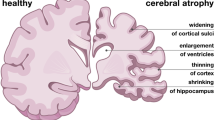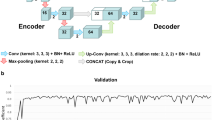Abstract
Background
Diffusion-weighted MR imaging (DWI) has been shown to be a great tool to assess white matter development in normal infants. Comparison of cerebral diffusion properties between preterm infants and fetuses of corresponding ages should assist in determining the impact of premature ex utero life on brain maturation.
Objective
To assess in utero maturation-dependent microstructural changes of fetal cerebral white matter using diffusion tensor MR imaging.
Materials and methods
An echoplanar sequence with diffusion gradient (b=700 s/mm2) applied in six non-colinear directions was performed between 31 and 37+3 weeks of gestation in 24 fetuses without cerebral abnormality on T1- and T2-weighted images. Apparent diffusion coefficient (ADC) and fractional anisotropy (FA) were measured in the white matter.
Results
Mean ADC values were 1.8 μm2/ms in the centrum semiovale, 1.2 μm2/ms in the splenium of the corpus callosum and 1.1 μm2/ms in the pyramidal tract. The paired Wilcoxon rank test showed significant differences in ADC between these three white matter regions. Mean FA values were 1.1%, 3.8% and 4.7%, respectively, in the centrum semiovale, corpus callosum and pyramidal tract. A significant age-related decrease in ADC and an increase in FA towards term were demonstrated in the pyramidal tract and corpus callosum.
Conclusion
Diffusion tensor imaging in utero can provide a quantitative assessment of the microstructural development of fetal white matter. Anisotropic parameters of the diffusion tensor should improve with technical advances.




Similar content being viewed by others
References
Forbes KPN, Pipe JG, Bird R, et al (2002) Changes in brain water diffusion during the first year of life. Radiology 222:405–409
Nomura Y, Sakuma H, Takeda K, et al (1994) Diffusional anisotropy of the human brain assessed with diffusion-weighted MR: relation with normal brain development and aging. AJNR 15:231–238
Schmithorst VJ, Wilke M, Dardzinski BJ, et al (2002) Correlation of white matter diffusivity and anisotropy with age during childhood and adolescence: a cross-sectional diffusion-tensor MR imaging study. Radiology 222:212–218
Samuka H, Nomura Y, Takeda K, et al (1991) Adult and neonatal human brain: diffusional anisotropy and myelination with diffusion-weighted MR imaging. Radiology 180:229–233
Pierpaoli C, Jezzard P, Basser PJ, et al (1996) Diffusion tensor MR imaging of the human brain. Radiology 201:637–648
Helenius J, Soinne L, Perkiö J, et al (2002) Diffusion-weighted MR imaging in normal brains in various age groups. AJNR 23:194–199
Engelbrecht V, Scherer A, Rassek M, et al (2002) Diffusion-weighted MR imaging in the brain in children: findings in the normal brain and in the brain with white matter diseases. Radiology 222:410–418
Toft PB, Leth H, Peitersen B, et al (1996) The apparent diffusion coefficient of water in gray and white matter of the infant brain. J Comput Assist Tomogr 20:1006–1011
Prayer D, Prayer L (2003) Diffusion-weighted magnetic resonance imaging of cerebral white matter development. Eur J Radiol 45:235–243
Hüppi PS, Maier SE, Peled S, et al (1998) Microstructural development of human newborn cerebral white matter assessed in vivo by diffusion tensor magnetic resonance imaging. Pediatr Res 44:584–590
Gressens P, Luton D (2004) Fetal MRI: obstetrical and neurological perspectives. Pediatr Radiol 34(9):682–684
Neil J, Shiran S, McKinstry RC, et al (1998) Normal brain in human newborns: apparent diffusion coefficient and diffusion anisotropy measured by using diffusion tensor MR imaging. Radiology 209:57–66
Tanner SF, Ragmenghi LA, Ridgway JP, et al (2000) Quantitative comparison of intrabrain diffusion in adults and preterm and term neonates and infants. AJR 174:1643–1649
Miller SP, Vigneron DB, Henry RG, et al (2002) Serial quantitative diffusion tensor MRI of the premature brain: development in newborns with and without injury. J Magn Reson Imaging 16:621–632
Righini A, Bianchini E, Parazzini C, et al (2003) Apparent diffusion coefficient determination in normal fetal brain: a prenatal MR imaging study. AJNR 24:799–804
Vergani P, Locatelli A, Strobelt N, et al (1998) Clinical outcome of mild fetal ventriculomegaly. Am J Obstet Gynecol 178:218–222
Bromley B, Frigoletto FD, Benacerraf BR, et al (1991) Mild lateral cerebral ventriculomegaly: clinical course and outcome. Am J Obstet Gynecol 164:863–867
Baker PN, Johnson IR, Harvey PR, et al (1993) A three-year follow-up of children imaged in utero with echo-planar magnetic resonance. Am J Obstet Gynecol 170:32–33
Baldoli C, Righini A, Parazzini C, et al (2002) Demonstration of acute ischemic lesions in the fetal brain by diffusion magnetic resonance imaging. Ann Neurol 52:243–246
Ito R, Mori S, Melhem ER, et al (2002) Diffusion tensor brain imaging and tractography. Neuroimaging Clin N Am 12(1):1–19
Barkovich AJ (2000) Concepts of myelin and myelination in neuroradiology. AJNR 21:1099–1109
Wimberger DM, Roberts TP, Barkovich AJ, et al (1995) Identification of “premyelination” by diffusion-weighted MRI. J Comput Assist Tomogr 19:28–33
Prayer D, Barkovich AJ, Kirschner A, et al (2001) Visualization of nonstructural changes in early white matter development on diffusion-weighted MR images: evidence supporting premyelination anisotropy. AJNR 22:1572–1576
Baratti C, Barnett AS, Pierpaoli C, et al (1999) Comparison MR imaging study of brain maturation in kittens with T1, T2, and the trace of the diffusion tensor. Radiology 210:133–142
Takeda K, Nomura Y, Sakuma H, et al (1997) MR assessment of normal brain development in neonates and infants: comparative study of T1- and diffusion-weighted images. J Comput Assist Tomogr 21:1–7
Author information
Authors and Affiliations
Corresponding author
Rights and permissions
About this article
Cite this article
Bui, T., Daire, JL., Chalard, F. et al. Microstructural development of human brain assessed in utero by diffusion tensor imaging. Pediatr Radiol 36, 1133–1140 (2006). https://doi.org/10.1007/s00247-006-0266-3
Received:
Revised:
Accepted:
Published:
Issue Date:
DOI: https://doi.org/10.1007/s00247-006-0266-3




